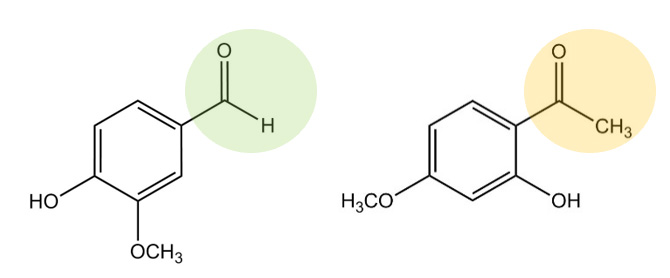Aldehydes & Ketones
es
fr
pt

Aldehydes & Ketones
As a renowned ISO 17025 testing laboratory and one of the leading international manufacturers of herbal standards, PhytoLab offers over 1,500 comprehensively documented reference substances of all natural substance classes. Our portfolio of phyproof® reference substances currently comprise a total of 36 aldehydes and ketones, most of which are certified as primary standards.
Occurrence and properties
The substance class of aldehydes and ketones includes many secondary plant substances that are found in a variety of plants.
Interesting representatives for ketones are, for example, Gingerols & Shogaols, which are found in ginger root (Zingiber officinale) and are responsible for its characteristic pungent flavour. These secondary plant substances protect the plant from predators and have shown antimicrobial, antiviral, antifungal and potentially anticarcinogenic properties in preclinical studies.
| Substance | Product | CAS | Substance class | Certificate | Occurence |
|---|---|---|---|---|---|
| 6-Gingerol | 89201 | 23513-14-6 | Ketone | P | Zingiber sp. |
| 8-Gingerol | 89202 | 23513-08-8 | Ketone | P | Zingiber sp. |
| 10-Gingerol | 89203 | 23513-15-7 | Ketone | P | Zingiber sp. |
| 6-Paradol | 10014 | 27113-22-0 | Ketone | P | Zingiber sp. |
| 6-Shogaol | 89792 | 555-66-8 | Ketone | C | Zingiber sp. |
| 8-Shogaol | 83910 | 36700-45-5 | Ketone | C | Zingiber sp. |
| 10-Shogaol | 83911 | 36752-54-2 | Ketone | C | Zingiber sp. |
Hericenes & Hericenones, which are found in lion's mane (Hericium erinaceus), belong to aldehydes as substance class. These bioactive substances of the medicinal mushroom are known for their diverse pharmacological properties alongside the diterpene (+)-Erinacin A, which is also contained in the mushroom. In preclinical studies, they show promising neuroprotective, anti-inflammatory and potentially anti-carcinogenic properties. They could therefore play a role in the prevention and treatment of neurological diseases.
| Substance | Product | CAS | Substance class | Certificate | Occurence |
|---|---|---|---|---|---|
| Hericene A | 24830 | 157207-54-0 | Aldehyde | P | Hericium sp. |
| Hericene D | 24832 | 1343477-87-1 | Aldehyde | P | Hericium sp. |
| Hericenone C | 24833 | 137592-03-1 | Aldehyde | P | Hericium sp. |
| Hericenone D | 24834 | 137592-04-2 | Aldehyde | P | Hericium sp. |
| Hericenone E | 24835 | 137592-05-3 | Aldehyde | P | Hericium sp. |
Two other important representatives of the aldehyde substance class are Oleacein & Oleocanthal, which are found in extra virgin olive oil (Olea europaea). These substances are said to have an antioxidant effect and are exclusively available from us as reference substances!
| Substance | Product | CAS | Substance class | Certificate | Occurence |
|---|---|---|---|---|---|
| Oleacein | 83881 | 149183-75-5 | Aldehyde | C | Olea sp. |
| Oleocanthal | 83882 | 1343477-87-1 | Aldehyde | C | Olea sp. |
Structure
Aldehydes and ketones have a carbonyl group (C=O) as their central structural element. Both carbonyl compounds are reactive due to the strongly polarised C=O bond. In addition, in aldehydes this is only linked to one C atom and one hydrogen atom (primary carbonyl group). In contrast, in ketones it is located within the carbon chain (secondary carbonyl group), which is why ketones are comparatively more stable.
A simple example of an aldehyde is Vanillin and a ketone is Paeonol :
 Figure 1. The aldehyde Vanillin (left) and the ketone Paeonol (right).
Figure 1. The aldehyde Vanillin (left) and the ketone Paeonol (right).Conclusion
Fully characterized reference substances are essential for a reliable quantitative analysis of ginger root (Zingiber officinale) or lion´s mane (Hericium erinaceus) products or natural olive oil (Olea europaea). We currently offer 12 aldehydes and 24 ketones, all of which are supplied with a comprehensive certificate of analysis. Key representatives include Gingerols & Shogaols, Hericenes & Hericenones, and Oleacein & Oleocanthal.
Up-to-date information on prices and specifications can be found on the article detail pages!
Reference Substances
- Alnustone
- Androsin
- Apocynin
- Asarylaldehyde
- Colupulone (stable DCHA salt)
- 3,4-Dihydroxybenzalacetone
- 6-Gingerol
- 8-Gingerol
- 10-Gingerol
- Glucovanillin
- Helicid
- Hericene A
- Hericene C
- Hericene D
- Hericenone C
- Hericenone D
- Hericenone E
- Hulupinic acid
- 4'-Hydroxyacetophenone
- 5-Hydroxy 1,7-diphenyl trans-6-hepten 3-one
- Hyperforin (stable Dicyclohexylammonium salt)
- Iriflophenone 3-C-glucoside
- Lupulone (stable DCHA salt)
- Muscone
- Nepodin
- Oleacein
- Oleocanthal
- Paeonol
- Paeonolide
- 6-Paradol
- Picein
- Picrocrocin
- Safranal
- 6-Shogaol
- 8-Shogaol
- 10-Shogaol
- Tinnevellin glucoside
- (+)-Usnic acid
- Vanillin


